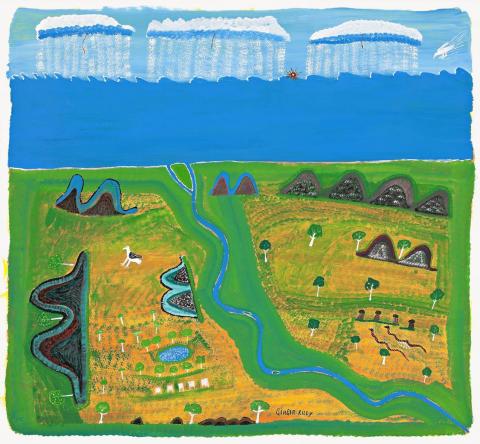STORMS AT SEA – SUNRISE IN SALT WATER COUNTRY,1997
GINGER RILEY MUNDUWALAWALA
synthetic polymer paint on cotton duck
194.0 x 210.0 cm
signed lower centre: GiNGER RiLEY
bears inscription verso: date, Alcaston Gallery cat. AK3680, cat. AK3 and cat. 9
Alcaston Gallery, Melbourne
Mr John McEnroe, USA
Private collection, Paris, acquired from the above
Nyamiyukanji, the river country, 1997, in the collection of the Art Gallery of New South Wales, Sydney, illus. in Tunicliff, W., Tradition today: Indigenous art in Australia, Art Gallery of New South Wales, Sydney, 2004, p. 91
Capture.JPG
JOHN McENROE MEETING
GINGER RILEY MUNDUWALAWALA
AT ALCASTON GALLERY,
MELBOURNE AT THE TIME OF HIS
PURCHASE
courtesy of Beverly Knight
Ginger Riley Munduwalawala grew up on the coastal salt-water country of the Mara people in south east Arnhem Land. He is the custodian of his mother's country, which extends from the coast of the Gulf of Carpentaria along the Limmen Bight River to the weather worn rocky outcrops known as the Four Archers some fifty kilometres inland. This landscape and its associated mythology is the primary subject matter of his art as Munduwalawala explains, 'My mother’s country is in my mind'.1 In this painting, Storms At Sea – Sunrise in Salt Water Country, 1997, a large and major canvas by the artist, he utilises his characteristic bright, luminous and often contrasting colours – ‘lots of colour, I play it up, the colour- too much!’2 – along with strong flattened forms, documenting this expansive country, incorporating elements of the landscape with images of mythological creation stories.
Whilst still in his adolescence, Munduwalawala met the watercolourist Albert Namatjira, whose style was to have an ongoing impact upon his practice. This meeting was to resonate considerably, forging 'Riley's idea that the colours of the land as seen in his imagination could be captured in art with munanga (white fella) paints'.3 Nearly two decades later, an opportunity arose when the Northern Territory Open College of TAFE established a printmaking workshop in the Ngukurr Aboriginal Community, formerly known as the Roper River Mission. Here Munduwalawala was to experiment with the munanga colours of blue, red and yellow, mixing them to create greens, purple and pink.
From his earliest work Riley was distinctive for his non-traditional aesthetic, employing brazen colour, subjects painted at dramatically different scales, unusual spatial arrangements, and crooked edged images. Riley's colour choices were daring and his technique and aesthetic were truly unique, which challenged Western ideas and expectations of Aboriginal painting. His catalogue of work can be viewed as a sequence of variations upon the same events. But the repetition of Riley's iconography is not a restriction, nor a lack of innovation. Rather, the endurance of his singular narrative allows for a greater depth of exploration, a greater revelation.
According to Munduwalawala's story, the snake Garimala, shown in the lower right of this painting as a pair of snakes, created the Four Archers, an area regarded as '... the centre of the earth, where all things start and finish’.4 Riley noted that Garimala travelled from far away and lives in the waterhole or billabong that he created near the Four Archers. Perched above to the left across the opposite side of the river and shown again swooping down from the top right corner is Ngak Ngak, the majestic white-breasted sea eagle who is the protector and guardian spirit of this country. This story is told during the rainy days of the Wet Season with the dawn sun just breaking above the horizon line of the ocean surface, spreading soft morning light across the sky.
Ginger Riley was a tremendously successful artist who received a plethora of awards throughout his lifetime, including the Telstra National Aboriginal and Torres Strait Islander Art Award in 1987, the John McCaughey Memorial Art Prize in 1993, the first National Aboriginal and Torres Strait Islander Heritage Commission Award in 1993, and an Australia Council Fellowship for 1997 – 98. He was also the first Aboriginal artist to be offered a major retrospective of his work at the National Gallery of Victoria in 1997.
1. Ryan, J., Ginger Riley, National Gallery of Victoria, Melbourne, 1997, p. 15
2. Ginger Riley quoted in Perkins H., Art and Soul, The Miegunyah Press, Carlton, 2010 p. 244
3. Ryan, J., op. cit., p. 15
4. ibid., p. 29
CRISPIN GUTTERIDGE
